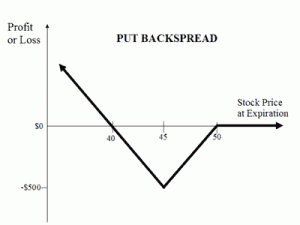Put back spreads are great strategies when you are expecting big downward moves in already volatile stocks. The trade itself involves selling a put at a higher strike and buying a greater number of puts at a lower strike price.
The put backspread is a strategy in options trading whereby the options trader writes a number of put options at a higher strike price (often at-the-money) and buys a greater number (often twice as many) of put options at a lower strike price (often out-of-the-money) of the same underlying stock and expiration date. Typically the strikes are selected such that the cost of the long puts is largely offset by the premium earned in writing the at-the-money puts. This strategy is generally considered very bearish but it can also serve as a neutral/bullish play under the right conditions.
Unlimited Profit Potential
The formula for calculating profit is given below:
- Maximum Profit = Unlimited
- Profit Achieved When Price of Underlying < 2 x Strike Price of Long Put – Strike Price of Short Put + Net Premium Received
- Profit = Strike Price of Long Put – Price of Underlying – Max Loss
This strategy profits when the stock price makes a strong move to the downside beyond the lower breakeven point. There is no limit to the maximum possible profit for the put backspread.
When to use: When you are bearish on market direction and bullish on volatility.
This strategy could also be referred to as a Short Put Backspread, however, I will refer to this strategy simply as a Put Backspread.
A Put Backspread should be done as a credit. This means that after you buy 2 OTM puts and sell 1 ITM put the net effect should be a credit to you. I.e. you should receive money for this spread as your are short more than you are long.
Put Backspread’s are a great strategy if you are bullish and bearish at the same time, however, have a bias to the downside. Looking from the payoff, you can see that if the market sells off you make unlimited profits below the break even point. If, however, you are wrong about the direction and the market stages a rally instead, you still win – though your profits are limited.
